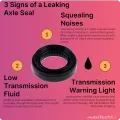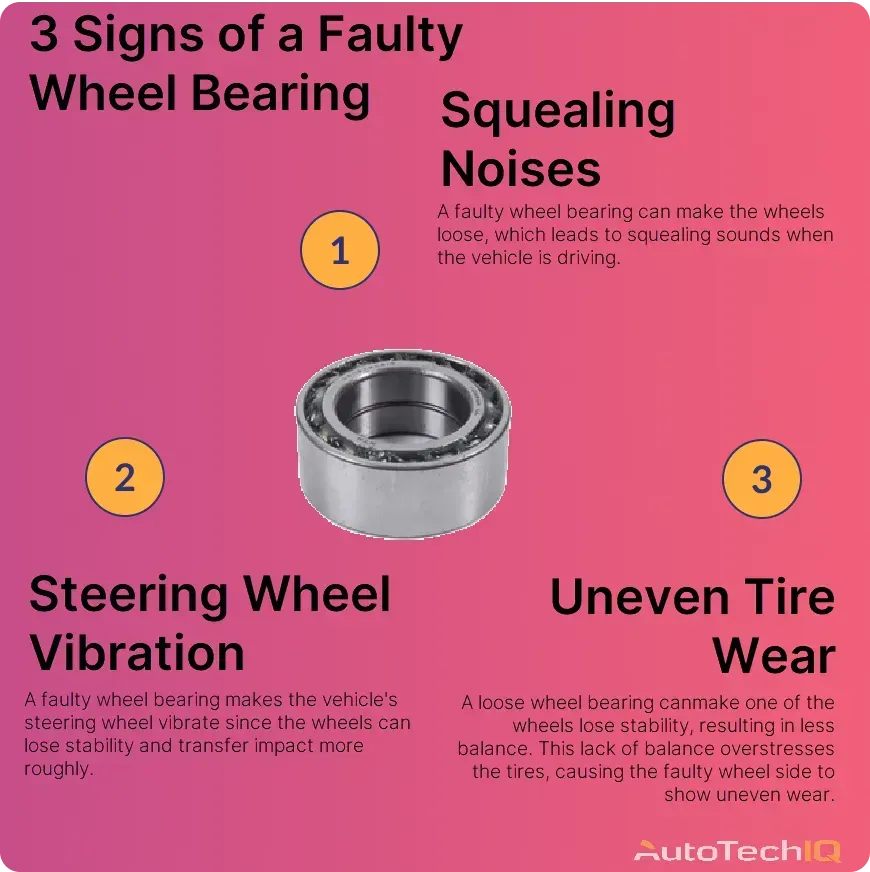
A faulty wheel bearing’s main signs are a squealing noise and vibrations while driving. The wheel bearing sits in the central part of the wheel, known as the hub assembly. The bearing connects the wheel to the suspension, allowing it to spin and rotate smoothly. But, if the wheel bearing is loose or faulty, the ride becomes shaky and the wheel makes humming or squealing noises.
The wheel bearing is vital for your vehicle’s stability, ensuring the suspension and wheel rotation work together to absorb impact during the ride.
-
Key function: The bearing’s main function is to make the wheel rotate and support the vehicle’s weight with minimal friction. It mainly provides stability, and wheel alignment, and improves handling and control of the vehicle.
A wheel bearing can bend, crack, damage, become sticky, rust, or many other issues. If the bearing is faulty, the vehicle will show symptoms.
-
Safety: Worn-out bearings are a major safety issue for any vehicle. A faulty or loose bearing can make your vehicle’s wheels wobble, make noise, degrade faster, or even lock up. If the wheel bearing’s condition is critical, the vehicle has little to no stability.

Wheel vibrations
Wheel bearings keep your vehicle’s wheels stabilized and properly connected to the suspension system. The bearing also helps your wheels support the vehicle’s weight while spinning smoothly.
Bad wheel bearings make the car lose stability, smoothness, and control, especially the front wheel bearings. Consequently, the wheel assembly becomes wobbly, making the car shaky. The vibration can even travel all the way to the steering wheel.
Squealing sounds
The wheel bearing keeps the wheels, suspension, and brakes tightly stabilized together. Therefore, if the bearing loosens up or becomes faulty, these systems can lose stability and start moving and banging erratically.
Unstable components around the wheels while the car is driving commonly lead to humming and squealing noises. This can happen both for the front and rear wheel bearings.
Other common signs
Here are other common signs that your vehicle’s serpentine belt might have slipped:
-
Humming noise
-
Vehicle pulling to one side
-
Tough handling
-
Uneven tire wear
-
ABS warning light
Possible fixes
-
Wheel bearing replacement: The wheel bearing can’t be fixed and in all cases replacing it is the safest decision.
-
Tire replacement: If the wheel bearing was causing wheel lock-ups or misalignment, the tires are possibly unevenly worn. Replacing the tires can be necessary.
-
Brake pad replacement: A faulty wheel bearing can lead to brake pad replacement because it can cause the wheel to wobble or become misaligned, which puts uneven pressure on the brake pads. This misalignment can cause the brake pads to wear unevenly or more quickly than usual, as they may constantly rub against the brake rotor, even when the brakes aren’t applied.
-
Suspension repair: A faulty wheel bearing can lead to suspension replacement because it disrupts the stability and alignment of the wheel, placing additional stress on suspension components like the struts, shocks, and control arms. As the wheel wobbles or misaligns due to a damaged bearing, these suspension parts are forced to compensate, leading to uneven wear and strain.
-
Wheel hub replacement: A faulty wheel bearing can lead to wheel hub replacement because the bearing is an integral part of the wheel hub assembly. When a wheel bearing fails, it can cause damage to the hub itself due to the increased friction, heat, and stress.
Frequently Asked Questions
What happens when a wheel bearing fails?
When a wheel bearing fails, several serious issues can occur. Initially, you may notice a grinding or humming noise that gets louder as you drive faster. The steering wheel might start to vibrate, especially when turning, and the vehicle could feel less stable or pull to one side. As the bearing deteriorates, the wheel may begin to wobble or become loose, which can compromise your ability to control the vehicle. In extreme cases, the wheel could even lock up or detach from the car, leading to a potential accident.
How long will a wheel bearing last after it starts making noise?
Once a wheel bearing starts making noise, its lifespan can vary, but it generally won’t last much longer. The noise is a sign that the bearing is already significantly worn or damaged, and continuing to drive with it can lead to rapid deterioration. In some cases, it might last a few hundred miles, while in others, it could fail within a few days or even sooner, depending on the severity of the damage and driving conditions.
Can you drive on a bad wheel bearing?
Driving on a bad wheel bearing is risky and not advisable. A failing wheel bearing can cause severe handling problems, such as wheel wobble, steering instability, and uneven tire wear, all of which compromise safety. Additionally, a bad wheel bearing can lead to further damage to the wheel hub, suspension, or brake components, potentially resulting in more expensive repairs and increasing the risk of a dangerous situation on the road.
Other news
-
Car is Squealing When Driving

-
What is Preventative Maintenance and What Are The Benefits of it?

-
JobViewIQ - DVI Process Training - Part of the Auto Care Alliance Benefits

-
7 Signs of AC Pulley Issues
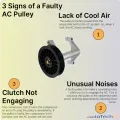
-
7 Signs of Clogged AC Components
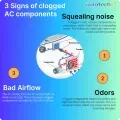
-
How Much Does a Transmission Fluid Change Cost?
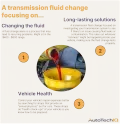
-
7 Signs of a Leaking Axle Seal
